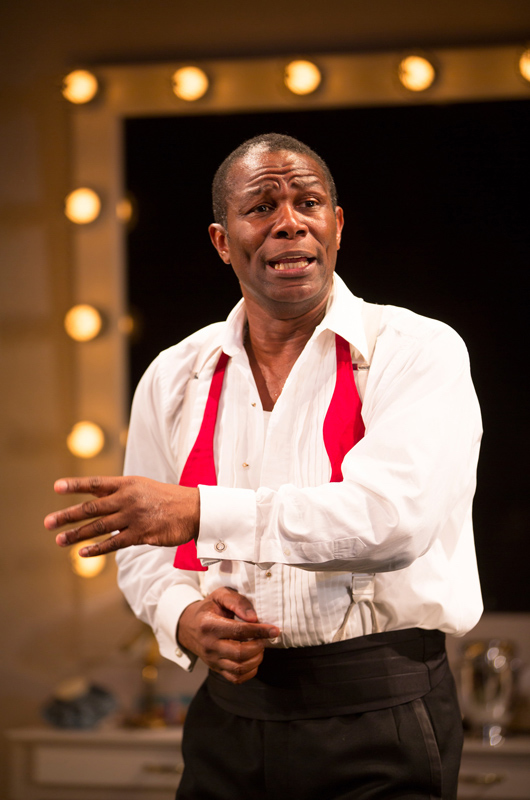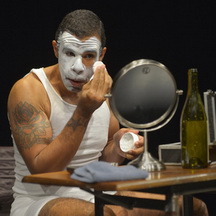
It’s hard to know where to begin describing Satchmo at the Waldorf. All the explanatory terms fall flat in giving an overall impression of this intelligently written and brilliantly acted play about the life of jazz cornetist Louis Armstrong.
The first play by critic, journalist and musician Terry Teachout, Satchmo has all the inspired freshness of a project taken on because of the writer’s thorough understanding, love and admiration for a man who was truly remarkable, not only for his musical genius but for his persistent drive. Armstrong, and this has been noted by others besides Teachout, was a man of joy. One whose ebullience ran deep, no matter the darkness surrounding him.
The play opens in a dressing room at the famed Waldorf Astoria. Satchmo comes staggering through the door to throw himself onto a couch where he can inhale oxygen from a tank. Calmed physically, he decides to make a tape talking about his life. He is 70 years old, and he’s come a long way – from the Storyville ghetto of New Orleans and the absolute poverty of his family to the hoity-toityest hotel in New York City. Along the way he has made millions, in both money and fans, and broken many barriers, creatively and politically.
Teachout avoids the pitfalls of walking the thin line between theater and documentation by making the play a one-man show and having the single actor play three characters. The most significant parts are those of Armstrong and his manager Joe Glaser. Because Glaser was white, Jewish and a businessman, he becomes an charged figure on several levels. Glaser, who was Armstrong’s manager for some 30 years, was a kind of surrogate father for the musician, handling all his business and advising Armstrong on his image, his musicians and his style of performance.
The third character, that of Miles Davis, has less weight. He is outside the “two sides of the same coin” relationship between Glaser and Armstrong, a mere rim of the coin, as it were. But he has a commanding theatrical presence, outlining the difference between Armstrong’s kind of entertainment, which Davis found racially demeaning, and the music of Miles, as the master of cool.
Shifting between the three roles requires some stylish acting, and John Douglas Thompson is the man. A respected Shakespearean actor with formidable chops, Thompson portrays all three characters with clarity and authority, shifting his body and speech to make distinct and immediately recognizable individual characters. The shift between Armstrong and Glaser requires the audience to discard the lens of racial determinism that we all are burdened with. In this way, it is a radical moment in our progress toward racially equality: it demands a moment of color blindness.
It is race and its history in the United States that is the core issue of Satchmo at the Waldorf. In some ways the music is just decoration, though ultimately Armstrong’s pivotal role in American jazz is perhaps of greater significance historically. But the man and his music are markers for changes in attitude and possibility within the culture.
My hat’s off to the creative team: Lee Savage (set), Kevin Adams (lighting), Ilona Somogyi (costumes) and John Gromada (sound), all of whom contribute to the definition of the characters and their theatrical impact. It’s Teachout and Director Gordon Edelstein who most enable the collaboration with Douglas. The three of them bring a resonant, compassionate and meaningful addition to our understanding of the racial struggle in our history and the significance of the single artist – both musician and actor – as a force of change.
– Jaime Robles
Satchmo at the Waldorf continues at ACT’s Geary Theater in San Francisco through February 7. For tickets and information, visit act-sf.org.
Photo: OBIE Award–winning John Douglas Thompson in Terry Teachout’s Satchmo at the Waldorf playing at ACT’s Geary Theater. Photo by T. Charles Erickson.
